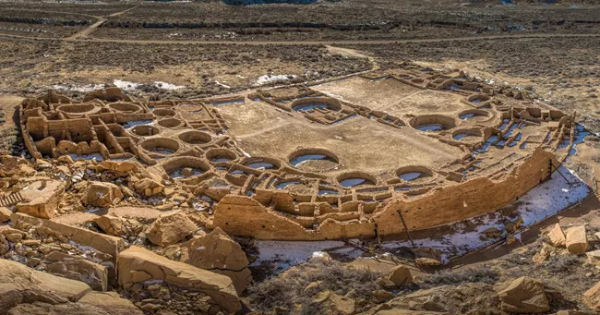From Tom Dispatch on 17 August 2023 comes a story headlined Michael Klare, A World on the Edge of … Collapse? The article is short, and it introduces a much longer article by Michael Klare, professor emeritus of peace and world security studies at Hampshire College.
I’ll read the complete introductory article by Tom Dispatch editor Tom Engelhardt:
“You can hardly turn on the TV news or go online these days without seeing… well, Donald Trump, of course, and his extreme version of American politics. Every indictment of him only seems to add to his strength in what’s no longer the Republican but the Trumpublican Party. Still, speaking of extremism (and disasters), I wouldn’t put him at the top of the list. This summer has offered us a scorchingly extreme version of climate change and a planet being burned, flooded, and melted in ever more unexpected and previously unimagined ways. Records are being set regularly with the year itself all too likely to take its place as the hottest ever — until, that is, next year on a planet where the last eight years have been the warmest in recorded history.
Oh, and if you happen to live on an island, here’s a little advice: get off it fast! Islands are going up in flames. Sardinia and Cyprus in the Mediterranean are now scorching messes and Hawaii’s Maui only recently became a first-class nightmare in which some residents had to plunge into the ocean to escape the flames. And if southern Europe, seemingly in an almost endless heatwave, continues to burn, northern Europe has been experiencing startlingly torrential rains and flooding.
Meanwhile, it’s not just Phoenix, Arizona, with those 31 straight days of 110 degrees Fahrenheit (or above), or even Chile, which recently passed 100 degrees Fahrenheit in what’s still known as… yes!… “winter” there. Temperatures have, in fact, been breaking records in an extreme fashion across the planet. It is, or should be, daunting, and yet, according to the latest polls, barely half of Americans (and only 23% of Republicans) consider the climate emergency a major threat and the leadership of one of our two parties — you know just which one I mean — is still into climate denialism (or simply the promotion of fossil-fuel use) in a remarkable fashion.
Were they to win power again in 2024, you could, I suspect, essentially kiss this planet goodbye. Unfortunately, as Tom Dispatch regular Michael Klare suggests today, you just might be able to do that no matter what happens in our politics.”
Michael Klare’s article, directly beneath the introduction by Engelhardt, is titled Collapse 2.0. It begins with an overview of Jared Diamond’s bestselling 2005 book Collapse: How Societies Choose to Fail or Succeed. Diamond’s book “focused on past civilizations that confronted severe climate shocks, either adapting and surviving or failing to adapt and disintegrating. Among those were the Puebloan culture of Chaco Canyon, New Mexico, the ancient Mayan civilization of Mesoamerica, and the Viking settlers of Greenland. Such societies, having achieved great success, imploded when their governing elites failed to adopt new survival mechanisms to face radically changing climate conditions.
Bear in mind that, for their time and place, the societies Diamond studied supported large, sophisticated populations. Pueblo Bonito, a six-story structure in Chaco Canyon, contained up to 600 rooms, making it the largest building in North America until the first skyscrapers rose in New York some 800 years later. The Mayan civilization is believed to have supported a population of more than 10 million people at its peak between 250 and 900 A.D., while the Norse Greenlanders established a distinctively European society around 1000 A.D. in the middle of a frozen wasteland. Still, in the end, each collapsed utterly and their inhabitants either died of starvation, slaughtered each other, or migrated elsewhere, leaving nothing but ruins behind.
The question today is: Will our own elites perform any better than the rulers of Chaco Canyon, the Mayan heartland, and Viking Greenland?”
Later in the article, in a section labeled Precursors of Collapse, Klare writes, “When do we know that a civilization is on the verge of collapse? In his now almost 20-year-old classic, Diamond identified three key indicators or precursors of imminent dissolution: a persistent pattern of environmental change for the worse like long-lasting droughts; signs that existing modes of agriculture or industrial production were aggravating the crisis; and an elite failure to abandon harmful practices and adopt new means of production. At some point, a critical threshold is crossed and collapse invariably follows.
Today, it’s hard to avoid indications that all three of those thresholds are being crossed.”
Klare then points out, “To begin with, on a planetary basis, the environmental impacts of climate change are now unavoidable and worsening by the year. To take just one among innumerable global examples, the drought afflicting the American West has now persisted for more than two decades, leading scientists to label it a “megadrought” exceeding all recorded regional dry spells in breadth and severity. As of August 2021, 99% of the United States west of the Rockies was in drought, something for which there is no modern precedent. The recent record heat waves in the region have only emphasized this grim reality.
The American West’s megadrought has been accompanied by another indicator of abiding environmental change: the steady decline in the volume of the Colorado River, the region’s most important source of water. The Colorado River Basin supplies drinking water to more than 40 million people in the United States and, according to economists at the University of Arizona, it’s crucial to $1.4 trillion of the U.S. economy. All of that is now at severe risk due to increased temperatures and diminished precipitation. The volume of the Colorado is almost 20% below what it was when this century began and, as global temperatures continue to rise, that decline is likely to worsen.
The most recent report of the Intergovernmental Panel on Climate Change offers many examples of such negative climate alterations globally (as do the latest headlines). It’s obvious, in fact, that climate change is permanently altering our environment in an ever more disastrous fashion.
It’s also evident that Diamond’s second precursor to collapse, the refusal to alter agricultural and industrial methods of production which only aggravate or — in the case of fossil-fuel consumption — simply cause the crisis, is growing ever more obvious. At the top of any list would be a continuing reliance on oil, coal, and natural gas, the leading sources of the greenhouse gases (GHGs) now overheating our atmosphere and oceans. Despite all the scientific evidence linking fossil-fuel combustion to global warming and the promises of governing elites to reduce the consumption of those fuels — for example, under the Paris Climate Agreement of 2015 — their use continues to grow.”
In a clear sign of the type of ignorance I’ve come to expect from anybody writing in a corporate outlet, Klare continues: “Not surprisingly, climate experts now predict that average world temperatures will soon surpass 1.5 degrees Celsius (2.7 degrees Fahrenheit) above the pre-industrial level — the maximum amount they believe the planet can absorb without experiencing irreversible, catastrophic consequences.”
As I have indicated many times previously in this space, Andrew Y. Glikson pointed out that we crossed the 2 C Rubicon in his 2020 book The Event Horizon. Later, as I pointed out recently, professor Leon Simons pointed out that several government agencies in the United States and Europe agreed with Glikson in October 2023.
Klare’s final sentences in this section, Precursors of Collapse, are these: “the precursors to civilizational collapse and the disintegration of modern industrial society as we know it — not to speak of the possible deaths of millions of us — are already evident. Worse yet, numerous events this very summer suggest that we are witnessing the first stages of just such a collapse.”
Really? The first stages of collapse? That seems stunningly naïve to me, and anybody else paying the slightest bit of attention.
Klare continues with a section titled The Apocalyptic Summer of ’23. This section begins with two climate events that indicate “an approaching Jared Diamond-style collapse.” Item 1 is the Canadian fires of 2023. The inability to protect its citizens suggests to Klare that Canada has been a failed state. Item 2 is the floods in China. As I have reported a few hundred times in this space, a warmer Earth is a wetter Earth. Not surprisingly, Beijing experienced its heaviest rainfall since record-keeping began. More than a million people had to be evacuated from flood-prone areas surrounding Beijing, and more than 100,000 acres of crops were damaged or destroyed.
Finally, Klare wraps up his article with this paragraph: “When and how we might slip over the brink into catastrophe is impossible to foresee. But as the events of this summer suggest, we are already all too close to the edge of the kind of systemic failure experienced so many centuries ago by the Mayans, the ancient Puebloans, and the Viking Greenlanders. The only difference is that we may have no place else to go. Call it, if you want, Collapse 2.0.”
Of course, there is no mention of the aerosol masking effect. Of course, there is no mention of the uncontrolled meltdown of nuclear facilities in the wake of societal collapse. The combination of these two factors indicates that the ensuing rapid rate of environmental change will cause the extinction of all life on Earth.
Personally, I would not call this “Collapse 2.0.” I’d be more inclined to call it what it is: The unbearably sad extinction of all life on the only planet known with certainty to support life. Collapse, Collapse 2.0, or any other descriptor that fails to indicate this horrific conclusion hardly begins to describe it.
Author
"Dr. Guy McPherson is an internationally recognized speaker, award-winning scientist, and the world’s leading authority on abrupt climate change leading to near-term human extinction. He is professor emeritus at the University of Arizona, where he taught and conducted research for twenty years. His published works include 14 books and hundreds of scholarly articles. Dr. McPherson has been featured on TV and radio and in several documentary films. He is a blogger, cultural critic, and co-host of his own radio show “Nature Bats Last.” Dr. McPherson speaks to general audiences across the globe, and to scientists, students, educators, and not-for-profit and business leaders who seek their best available options when confronting Earth’s cataclysmic changes." source





